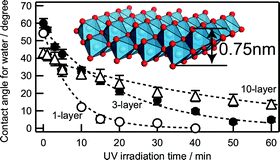Photocatalytic properties of titania nanostructured films fabricated from titania nanosheets†
Abstract
We examined the photochemical properties of well-ordered multilayer films of titania

* Corresponding authors
a
Nanoscale Materials Center, National Institute for Materials Science, 1-1 Namiki, Tsukuba, Ibaraki, Japan
E-mail:
sasaki.takayoshi@nims.go.jp
Fax: +81-29-854-9061
Tel: +81-29-860-4313
We examined the photochemical properties of well-ordered multilayer films of titania

 Please wait while we load your content...
Something went wrong. Try again?
Please wait while we load your content...
Something went wrong. Try again?
T. Shibata, N. Sakai, K. Fukuda, Y. Ebina and T. Sasaki, Phys. Chem. Chem. Phys., 2007, 9, 2413 DOI: 10.1039/B618448K
To request permission to reproduce material from this article, please go to the Copyright Clearance Center request page.
If you are an author contributing to an RSC publication, you do not need to request permission provided correct acknowledgement is given.
If you are the author of this article, you do not need to request permission to reproduce figures and diagrams provided correct acknowledgement is given. If you want to reproduce the whole article in a third-party publication (excluding your thesis/dissertation for which permission is not required) please go to the Copyright Clearance Center request page.
Read more about how to correctly acknowledge RSC content.
 Fetching data from CrossRef.
Fetching data from CrossRef.
This may take some time to load.
Loading related content
